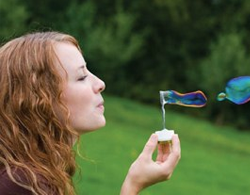Nanooze Blog
Bacteria Can Grow Nanowires That Carry Electricity
 When you turn on a light at home, the bulb lights up because an electric current has travelled from the breaker box in your home’s electrical system to the outlet the lamp is plugged into, and on through the power cord to provide electrical power to the light so it can glow. If you can imagine this process happening on a very tiny scale, you’ll have some idea about why scientists are excited to discover there is a strain of bacteria that can actually make extremely small wires that conduct electricity. This Geobacter bacteria has been shown to be useful at cleaning up toxic spills, and very recently has been shown to create long, thin nanowires that can send electricity back and forth. This could find lots of applications in engineering and systems biology, but more importantly — it’s really cool!
When you turn on a light at home, the bulb lights up because an electric current has travelled from the breaker box in your home’s electrical system to the outlet the lamp is plugged into, and on through the power cord to provide electrical power to the light so it can glow. If you can imagine this process happening on a very tiny scale, you’ll have some idea about why scientists are excited to discover there is a strain of bacteria that can actually make extremely small wires that conduct electricity. This Geobacter bacteria has been shown to be useful at cleaning up toxic spills, and very recently has been shown to create long, thin nanowires that can send electricity back and forth. This could find lots of applications in engineering and systems biology, but more importantly — it’s really cool!
Source:Bacteria grow conductive wires
HiRise camera will take high quality photographs of Mars
 Have you ever dreams of going into space? How about to hop over to Mars and see what it’s like? Well, even if you don’t get there yourself you can at least have the next best thing pretty soon — the most high quality images of the red planet ever taken will be beamed back down to Earth in the coming months. To get them, NASA is sending the largest camera ever sent out of Earth’s orbit. It’s called HiRise, and it takes images that are so high quality that just one of them would take 1,200 regular computer monitors to displau the whole thing! Even though the camera will be in orbit about 300 kilometers above Mars’s surface, it will be able to identify and photograph objects as small as a coffee table on the planet’s surface. So, if you can’t get into orbit yourself, at least we have HiRise to let us know what it would look like!
Have you ever dreams of going into space? How about to hop over to Mars and see what it’s like? Well, even if you don’t get there yourself you can at least have the next best thing pretty soon — the most high quality images of the red planet ever taken will be beamed back down to Earth in the coming months. To get them, NASA is sending the largest camera ever sent out of Earth’s orbit. It’s called HiRise, and it takes images that are so high quality that just one of them would take 1,200 regular computer monitors to displau the whole thing! Even though the camera will be in orbit about 300 kilometers above Mars’s surface, it will be able to identify and photograph objects as small as a coffee table on the planet’s surface. So, if you can’t get into orbit yourself, at least we have HiRise to let us know what it would look like!
Source: High-Resolution Camera to Survey Mars
The SAUVIM Underwater Vehicle Pilots Itself
 You’ve probably seen all kinds of robots — some that look like cars, some that look like lots of metal and wires, and some that even look like people. This robot is called the SAUVIM robot, and it’s the first robot that’s designed to travel by itself underwater. It’s about the size of an SUV and can dive up to 4 miles beneath the ocean. Its computer brain can control an attached 150-pound robotic arm that can pick up objects on the sea floor — and someday, maybe even fix things like underwater pipes or other structures built beneath the ocean surface.
You’ve probably seen all kinds of robots — some that look like cars, some that look like lots of metal and wires, and some that even look like people. This robot is called the SAUVIM robot, and it’s the first robot that’s designed to travel by itself underwater. It’s about the size of an SUV and can dive up to 4 miles beneath the ocean. Its computer brain can control an attached 150-pound robotic arm that can pick up objects on the sea floor — and someday, maybe even fix things like underwater pipes or other structures built beneath the ocean surface.
Source:The Hawaiian Autonomous Undersea Robot
Nanotechnology for Drummers
 Have you ever been to a concert where one of the performers is a live drummer? Maybe you’ve seen all the microphones attached to the different pieces of drum kit. Drummers need to use these microphones to amplify their sound, so that their volume can be loud enough to balance the volume of the other players in the group. But placing all of those microphones is very complicated and often takes a lot of time to set up. A company called B-Band has made a new device based on nanotechnology that would let drummers use a permanently installed piece of equipment called a pickup instead of using microphones. It’s not a pickup like a truck — it’s a pickup that takes the vibrations from hitting a drum and converts them to an electronic signal that can be amplified or even recorded. Drummers would install this pickup, made of a very special plastic made up of tiny elastic fibers, and could get a much louder sound from their drums without having to use any microphones. It already takes a lot of time just to set up the drum kit alone, so these pickups could save time and make a lot of drummers very happy!
Have you ever been to a concert where one of the performers is a live drummer? Maybe you’ve seen all the microphones attached to the different pieces of drum kit. Drummers need to use these microphones to amplify their sound, so that their volume can be loud enough to balance the volume of the other players in the group. But placing all of those microphones is very complicated and often takes a lot of time to set up. A company called B-Band has made a new device based on nanotechnology that would let drummers use a permanently installed piece of equipment called a pickup instead of using microphones. It’s not a pickup like a truck — it’s a pickup that takes the vibrations from hitting a drum and converts them to an electronic signal that can be amplified or even recorded. Drummers would install this pickup, made of a very special plastic made up of tiny elastic fibers, and could get a much louder sound from their drums without having to use any microphones. It already takes a lot of time just to set up the drum kit alone, so these pickups could save time and make a lot of drummers very happy!
Source: Nanotech gives drumkits a makeover
Robots Could Work with Humans on Space Missions
 Sending people into space can not only be very risky, but also very expensive. Human missions need a lot of support from teams on the ground. One way of keeping costs lower would be to use robots in place of at least some of the human astronauts on space missions. But the trouble is, these robots would have to be very smart in order to be useful. Scientists at the University of Liverpool are working with NASA to develop software for robots that would help them act intelligently, to “think” and make decisions on their own. These smart robots would be able to help humans on space missions by carrying out complex tasks — or even someday explore space on their own, with help from humans on the ground. Can you imagine a group of robots exploring the moon?
Sending people into space can not only be very risky, but also very expensive. Human missions need a lot of support from teams on the ground. One way of keeping costs lower would be to use robots in place of at least some of the human astronauts on space missions. But the trouble is, these robots would have to be very smart in order to be useful. Scientists at the University of Liverpool are working with NASA to develop software for robots that would help them act intelligently, to “think” and make decisions on their own. These smart robots would be able to help humans on space missions by carrying out complex tasks — or even someday explore space on their own, with help from humans on the ground. Can you imagine a group of robots exploring the moon?
Source: Liverpool scientists to develop space robots with NASA
Join Your Favorite TV GameShow from Your Phone
 Have you ever seen a game show on TV? How would you like to be a part of the show, without ever having to leave your own house? In fact, could you imagine being on the game show by sending in videos of yourself taken from a cellphone? Maybe you don’t have a cellphone yet, but your parents do. In the United States, more and more cellphones are able to take pictures and even record videos, right on the phone. Then, you can send the photos and videos wirelessly, through the air, to your friends or to a special address that can publish your videos on the web. In Europe, they’ve been testing a system where people can send in videos of themselves to a live TV game show, and have their video clip incorporated right into the TV show they’re watching. Can you imagine being a part of your favorite TV show someday?
Have you ever seen a game show on TV? How would you like to be a part of the show, without ever having to leave your own house? In fact, could you imagine being on the game show by sending in videos of yourself taken from a cellphone? Maybe you don’t have a cellphone yet, but your parents do. In the United States, more and more cellphones are able to take pictures and even record videos, right on the phone. Then, you can send the photos and videos wirelessly, through the air, to your friends or to a special address that can publish your videos on the web. In Europe, they’ve been testing a system where people can send in videos of themselves to a live TV game show, and have their video clip incorporated right into the TV show they’re watching. Can you imagine being a part of your favorite TV show someday?
Source: Videophoning: Live on Television from Your Living Room
The Race of the Driverless Cars
 Would you ride in a robotic vehicle that drives itself? If you can believe it, there’s a whole contest where a bunch of driverless cars will try to beat each other to the finish line in a 200 mile race. The race, called the Grand Challengeis sponsored by the Defense Advanced Research Projects Agency (DARPA), and many teams are working on building robot cars to compete in the event. The race will be October 8, and the track is located in the Mojave Desert — can you imagine a fleet of 20 robot vehicles racing each other across the desert?
Would you ride in a robotic vehicle that drives itself? If you can believe it, there’s a whole contest where a bunch of driverless cars will try to beat each other to the finish line in a 200 mile race. The race, called the Grand Challengeis sponsored by the Defense Advanced Research Projects Agency (DARPA), and many teams are working on building robot cars to compete in the event. The race will be October 8, and the track is located in the Mojave Desert — can you imagine a fleet of 20 robot vehicles racing each other across the desert?
Source:Sandstorm robot makes unprecedented 200-mile autonomous run
Nanowires Can Help Scientists Watch Single Brain Cells
 If you were a scientist studying the brain, you would want to get as many details as you could about how even the smallest part of the brain works. A single brain cell, called a neuron, is very difficult to observe in its natural state, because it’s on the inside of you! It’s also very small, so doctors and scientists need to find other ways to look at brain cells besides viewing them directly. One new idea is to use very tiny wires called nanowires — 100 times thinner than a human hair — to guide through the blood system and into the brain. Because the wires are so small, scientists could guide them to locations where they touch a single nerve cell and monitor its electrical activity. This would give them a much closer picture of how these brain cells are working, closer than the techniques they use now which tell them things about small regions of brain tissue made up of many, many brain cells. This technique hasn’t yet been tried on human beings, but a successful test of the nanowire technique was run on tissue samples in laboratory. Maybe someday you’ll even be able to watch your own neurons as they work inside your brain!
If you were a scientist studying the brain, you would want to get as many details as you could about how even the smallest part of the brain works. A single brain cell, called a neuron, is very difficult to observe in its natural state, because it’s on the inside of you! It’s also very small, so doctors and scientists need to find other ways to look at brain cells besides viewing them directly. One new idea is to use very tiny wires called nanowires — 100 times thinner than a human hair — to guide through the blood system and into the brain. Because the wires are so small, scientists could guide them to locations where they touch a single nerve cell and monitor its electrical activity. This would give them a much closer picture of how these brain cells are working, closer than the techniques they use now which tell them things about small regions of brain tissue made up of many, many brain cells. This technique hasn’t yet been tried on human beings, but a successful test of the nanowire technique was run on tissue samples in laboratory. Maybe someday you’ll even be able to watch your own neurons as they work inside your brain!
Source: Wiring the Brain at the Nanoscale
Tiny Nanotubes Could Help Heal Broken Bones
 So we’ve been talking a little bit about carbon nanotubes in some of the stories below. If you remember, scientists are finding lots of different ways these nanotubes can be useful, because they are very light but also very strong. One more way scientists have found to use carbon nanotubes is in healing broken bones. Doctors often use something called a scaffold to help the body’s natural healing process when a bone is broken, because the scaffold helps provide a strong support to make sure the new bone tissue grows in correctly. The trouble is, keeping these scaffolds in place can often involve the patient needing to wear complicated and uncomfortable supports while the bone is healing. Now, scientists are hopeful that carbon nanotubes can be used in place of these mechanical scaffolds. They’ve shown that nanotubes do a very good job acting like collagen, which is one of the most important materials in your bones. Instead of needing to implant synthetic scaffolds, scientists may one day be able to inject a small amount of the nanotubes into a broken bone and simply wait for it to heal. This would make healing a broken bone a lot easier for both the patient and for doctors, but it won’t make breaking a bone hurt any less!
So we’ve been talking a little bit about carbon nanotubes in some of the stories below. If you remember, scientists are finding lots of different ways these nanotubes can be useful, because they are very light but also very strong. One more way scientists have found to use carbon nanotubes is in healing broken bones. Doctors often use something called a scaffold to help the body’s natural healing process when a bone is broken, because the scaffold helps provide a strong support to make sure the new bone tissue grows in correctly. The trouble is, keeping these scaffolds in place can often involve the patient needing to wear complicated and uncomfortable supports while the bone is healing. Now, scientists are hopeful that carbon nanotubes can be used in place of these mechanical scaffolds. They’ve shown that nanotubes do a very good job acting like collagen, which is one of the most important materials in your bones. Instead of needing to implant synthetic scaffolds, scientists may one day be able to inject a small amount of the nanotubes into a broken bone and simply wait for it to heal. This would make healing a broken bone a lot easier for both the patient and for doctors, but it won’t make breaking a bone hurt any less!
Source: Nanotubes inspire new technique for healing broken bones
Would You Eat Meat Grown in a Laboratory?
 Who would want to grow meat in a lab? Well, astronauts on long space flights might be interested, because regular meat would take up a lot of space in a small spacecraft. NASA has shown that just such a thing can be done on a small scale — but maybe we could find some benefits from producing meat on a large scale, large enough that you could buy it at the supermarket. The industry that produces meat from livestock like cows and chickens is very hard on the environment, because it causes pollution. There are also drugs that are given to animals raised for meat that can cause health problems. Also, if we could make our meat in a laboratory, we could replace some of the bad fats that cause cholesterol with healthier kinds of fats. So you see, there are some good reasons that scientists are looking at ways of growing chicken nuggets without the chicken!
Who would want to grow meat in a lab? Well, astronauts on long space flights might be interested, because regular meat would take up a lot of space in a small spacecraft. NASA has shown that just such a thing can be done on a small scale — but maybe we could find some benefits from producing meat on a large scale, large enough that you could buy it at the supermarket. The industry that produces meat from livestock like cows and chickens is very hard on the environment, because it causes pollution. There are also drugs that are given to animals raised for meat that can cause health problems. Also, if we could make our meat in a laboratory, we could replace some of the bad fats that cause cholesterol with healthier kinds of fats. So you see, there are some good reasons that scientists are looking at ways of growing chicken nuggets without the chicken!
Source: Growing Nuggets Without the Chicken? Paper Says Edible Meat Can Be Grown in a Lab
This Spacesuit Turns You into a Geologist
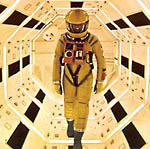 How’d you like to put on a spacesuit? Better yet — how’d you like to put on a spacesuit that will give you skills that would help you look for life on other planets? That’s exactly what researchers in Spain have built. Geology is the study of rocks — by looking at what makes up the rocks, we can learn a lot about the history of our own planet as well as other planets. The spacesuit the Spanish scientists have built has a built-in computer system that can help analyze ancient rocks on other planets, and tell astronauts whether or not those rocks contain any signs of water or life. In fact, the suit can even tell you which rocks you’d need to examine more closely, by using a special video camera to scan the landscape. When the computer finds a rock formation that might be interesting, it will send an alert right to a display inside your helmet. Maybe someday if you’re lucky enough to be an astronaut, this kind of spacesuit can turn you into an instant geologist, too! Source: Space suits with geology skills built in
How’d you like to put on a spacesuit? Better yet — how’d you like to put on a spacesuit that will give you skills that would help you look for life on other planets? That’s exactly what researchers in Spain have built. Geology is the study of rocks — by looking at what makes up the rocks, we can learn a lot about the history of our own planet as well as other planets. The spacesuit the Spanish scientists have built has a built-in computer system that can help analyze ancient rocks on other planets, and tell astronauts whether or not those rocks contain any signs of water or life. In fact, the suit can even tell you which rocks you’d need to examine more closely, by using a special video camera to scan the landscape. When the computer finds a rock formation that might be interesting, it will send an alert right to a display inside your helmet. Maybe someday if you’re lucky enough to be an astronaut, this kind of spacesuit can turn you into an instant geologist, too! Source: Space suits with geology skills built in
Nanoparticles can help solve crimes
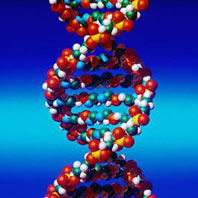 Maybe you’ve heard of DNA tests being used to help solve crimes. A few flakes of skin or a hair found at the scene of a crime can be used by scientists to make a kind of genetic fingerprint that can help identify whether a particular person was the criminal or not. This is because our DNA is very unique — so unique that no one else will have DNA that is quite like yours. Scientists use a special method called PCR, or polymerase chain reaction, to take the DNA from a very small sample like a hair and make lots and lots of copies of it — which makes the DNA easier to look at and analyze. It turns out that very tiny particles of gold can help this PCR process work a lot better, and generate even more copies from the original amount of DNA. This means that gold nanoparticles could be considered the world’s smallest crimefighters! Source:
Maybe you’ve heard of DNA tests being used to help solve crimes. A few flakes of skin or a hair found at the scene of a crime can be used by scientists to make a kind of genetic fingerprint that can help identify whether a particular person was the criminal or not. This is because our DNA is very unique — so unique that no one else will have DNA that is quite like yours. Scientists use a special method called PCR, or polymerase chain reaction, to take the DNA from a very small sample like a hair and make lots and lots of copies of it — which makes the DNA easier to look at and analyze. It turns out that very tiny particles of gold can help this PCR process work a lot better, and generate even more copies from the original amount of DNA. This means that gold nanoparticles could be considered the world’s smallest crimefighters! Source:
Gold nanoparticles improve sensitivity and specificity of genetic analysis and diagnosis
Could Computers be Made Out of Light?
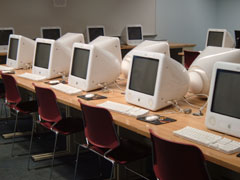 You might know that computers today use electrons to pass signals back and forth on silicon chips. But scientists are always looking for better and faster ways to send and store information, and are dreaming about what computers of the future would look like. One idea is that computers can be made smaller — much, much, smaller — only the size of a handful of atoms! This idea of very, very small computers is called quantum computing. Quantum computing is still a long way away, but scientists are hopeful that it could completely change the way we use computers. One group of scientists thinks we could make optical quantum computers: computers that use light to communicate. Light is made up of tiny particles called photons, and these photons could take the place of electrons to send signals back and forth inside the computer. What do you think a computer made out of light would look like?
You might know that computers today use electrons to pass signals back and forth on silicon chips. But scientists are always looking for better and faster ways to send and store information, and are dreaming about what computers of the future would look like. One idea is that computers can be made smaller — much, much, smaller — only the size of a handful of atoms! This idea of very, very small computers is called quantum computing. Quantum computing is still a long way away, but scientists are hopeful that it could completely change the way we use computers. One group of scientists thinks we could make optical quantum computers: computers that use light to communicate. Light is made up of tiny particles called photons, and these photons could take the place of electrons to send signals back and forth inside the computer. What do you think a computer made out of light would look like?
Source: HP researchers propose new path to optical quantum computing
Would You Eat Nanofood?
 You may already know that the food you eat is made up of lots of tiny particles that your body breaks down and digests to give you energy. But what if our food had other kinds of particles in it, say, very small nanoparticles that could change the color of your soda, for example? Scientists are looking at the idea of putting just those kinds of particles into our food for a number of reasons: to make it easier to take medicines, better deliver nutrients, and yes — even to change the flavor or texture of what you’re eating as you eat it! It’s still a long way off until we’d be able to buy anything like this in a grocery store, but imagine that someday companies might sell a kind of candy that would let you decide for yourself what flavor and color it would be. Now that’s some fun food!
You may already know that the food you eat is made up of lots of tiny particles that your body breaks down and digests to give you energy. But what if our food had other kinds of particles in it, say, very small nanoparticles that could change the color of your soda, for example? Scientists are looking at the idea of putting just those kinds of particles into our food for a number of reasons: to make it easier to take medicines, better deliver nutrients, and yes — even to change the flavor or texture of what you’re eating as you eat it! It’s still a long way off until we’d be able to buy anything like this in a grocery store, but imagine that someday companies might sell a kind of candy that would let you decide for yourself what flavor and color it would be. Now that’s some fun food!
Source: Are you ready for Nanofood?
Nanoparticles Help Treat Cancer
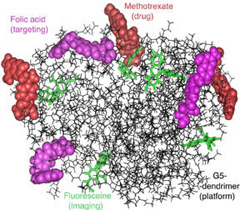 When someone has cancer, doctors often treat them with a number of different drugs that help to kill the cancer cells. The problem is, sometimes healthy cells get harmed by the very powerful drugs that doctors only want to work on the bad cells. Now scientists have found a way to use very tiny nanoparticles to help solve the problem of the drugs hurting the good cells. They take a small particle that looks almost like a very tiny tree, and attach the anti-cancer drug to some of the tree’s branches. They also attach another chemical called folic acid to some of the other branches. Cancer cells are very, very hungry for folic acid, so they gobble up the nanoparticles with the folic acid attached faster than normal, healthy cells do. This means the powerful anti-cancer drugs can act on mostly the bad cancer cells without harming the good, non-cancer cells.This makes those tiny nanoparticles very useful trees, indeed!
When someone has cancer, doctors often treat them with a number of different drugs that help to kill the cancer cells. The problem is, sometimes healthy cells get harmed by the very powerful drugs that doctors only want to work on the bad cells. Now scientists have found a way to use very tiny nanoparticles to help solve the problem of the drugs hurting the good cells. They take a small particle that looks almost like a very tiny tree, and attach the anti-cancer drug to some of the tree’s branches. They also attach another chemical called folic acid to some of the other branches. Cancer cells are very, very hungry for folic acid, so they gobble up the nanoparticles with the folic acid attached faster than normal, healthy cells do. This means the powerful anti-cancer drugs can act on mostly the bad cancer cells without harming the good, non-cancer cells.This makes those tiny nanoparticles very useful trees, indeed!
The Bugbot Can See Inside You
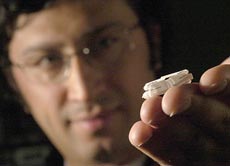
Steve Mellon/Post-Gazette. Metin Sitti, a mechanical engineer at Carnegie Mellon University, displays a six-legged device he’s developing that will someday be capable of making images inside small intestines. Sitti specializes in micromechanical devices. Post-Gazette photo by Steve Mellon in PIttsburgh on Wednesday, May 25, 2005. Story for Science by Byron Spice. Digital.
How would you feel about a robot bug crawling inside of you? At Carnegie Mellon Univeristy, scientists are making a medical robot that can do just that, but it’s not just to gross you out! The Bugbot is a very tiny robot with six legs and a camera that can travel in your digestive system and take pictures. Doctors will be able to use the Bugbot to deliver drugs to very specific places in your body, which means you would feel less of the side effects of some of the powerful drugs used to treat diseases. The Bugbot can also help doctors catch diseases much earlier, so that you could be treated and prevent a lot of the damage the disease might cause to your body. Someday, the robot bug could even help doctors perform surgeries. Maybe it sounds a little bit creepy to talk about a robot performing surgery, but it could actually make the process a lot less painful!
Source:The ‘Bugbot,’ a Robot with Six Legs and a Camera
Nanotechnology Can Light Up Your Brain
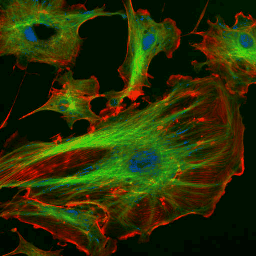 Our brain cells are changing all the time. They’re full of chemicals that send messages from one cell to another, but they’re much faster than the telephone! If scientists had a way of looking at those chemicals in our brains as they change, it would help them find out more about how our brains work, and help figure out how to treat diseases in our brains when they’re not working properly. Now nanotechnology gives scientists a way to do that, by using very tiny molecules that change color when they meet up with the chemicals in our brian cells. We say that these tiny molecules are fluorescent, because they give off a special kind of light. Do you know what a black light is? Have you ever seen your white t-shirt glowing under a black light? That glow is also a kind of fluorescence. Imagine that scientists can hold up a black light to our brain cells and see how much of a certain chemical is present by how much it glows. By watching how the glow changes over time, they can get a better idea of what a healthy brain looks like as compared to a diseased brain. This will help them make better drugs for treating diseases like Alzheimer’s and Parkinson’s Disease, and help us keep our brains healthy longer!
Our brain cells are changing all the time. They’re full of chemicals that send messages from one cell to another, but they’re much faster than the telephone! If scientists had a way of looking at those chemicals in our brains as they change, it would help them find out more about how our brains work, and help figure out how to treat diseases in our brains when they’re not working properly. Now nanotechnology gives scientists a way to do that, by using very tiny molecules that change color when they meet up with the chemicals in our brian cells. We say that these tiny molecules are fluorescent, because they give off a special kind of light. Do you know what a black light is? Have you ever seen your white t-shirt glowing under a black light? That glow is also a kind of fluorescence. Imagine that scientists can hold up a black light to our brain cells and see how much of a certain chemical is present by how much it glows. By watching how the glow changes over time, they can get a better idea of what a healthy brain looks like as compared to a diseased brain. This will help them make better drugs for treating diseases like Alzheimer’s and Parkinson’s Disease, and help us keep our brains healthy longer!
Source:Revolutionary nanotechnology illuminates brain cells at work
Nanotech bikes used in the Tour de France
 You know about carbon nanotubes, right? They’re very, very tiny tubes made only of carbon, and they’re very, very strong. They’re also very light, which makes them good for building things that need to be both strong and light. Do you know what the Tour de France is? It’s a very famous bike race that happens every year. This year will be the first time that some of the racers will be using bikes that are built with carbon nanotubes. These bikes are lighter that many other bikes because of the carbon nanotubes, and will help racers travel faster with less effort. They’re also tough so they won’t break easily. We’ll have to wait and see if one of the nanotube bikes helps someone win the race!
You know about carbon nanotubes, right? They’re very, very tiny tubes made only of carbon, and they’re very, very strong. They’re also very light, which makes them good for building things that need to be both strong and light. Do you know what the Tour de France is? It’s a very famous bike race that happens every year. This year will be the first time that some of the racers will be using bikes that are built with carbon nanotubes. These bikes are lighter that many other bikes because of the carbon nanotubes, and will help racers travel faster with less effort. They’re also tough so they won’t break easily. We’ll have to wait and see if one of the nanotube bikes helps someone win the race!
Source: Nanotube bikes to be used in the Tour de France
How Small Can a Brush Be??
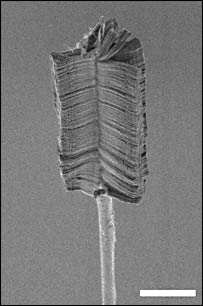
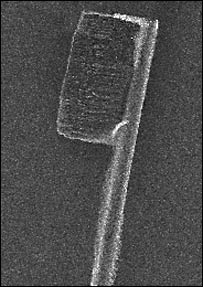 Nanotech Scientists have built a very small brush with bristles just 30 nm (nanometers) across and about 100nm long. This brush is made out of nanotubes, tiny straw-like molecules, extraordinarily small just 30 billionth of a meter across. The new nanobrush could be used to brush off small dust particles, to clean water or even to paint very small surfaces.
Nanotech Scientists have built a very small brush with bristles just 30 nm (nanometers) across and about 100nm long. This brush is made out of nanotubes, tiny straw-like molecules, extraordinarily small just 30 billionth of a meter across. The new nanobrush could be used to brush off small dust particles, to clean water or even to paint very small surfaces.

